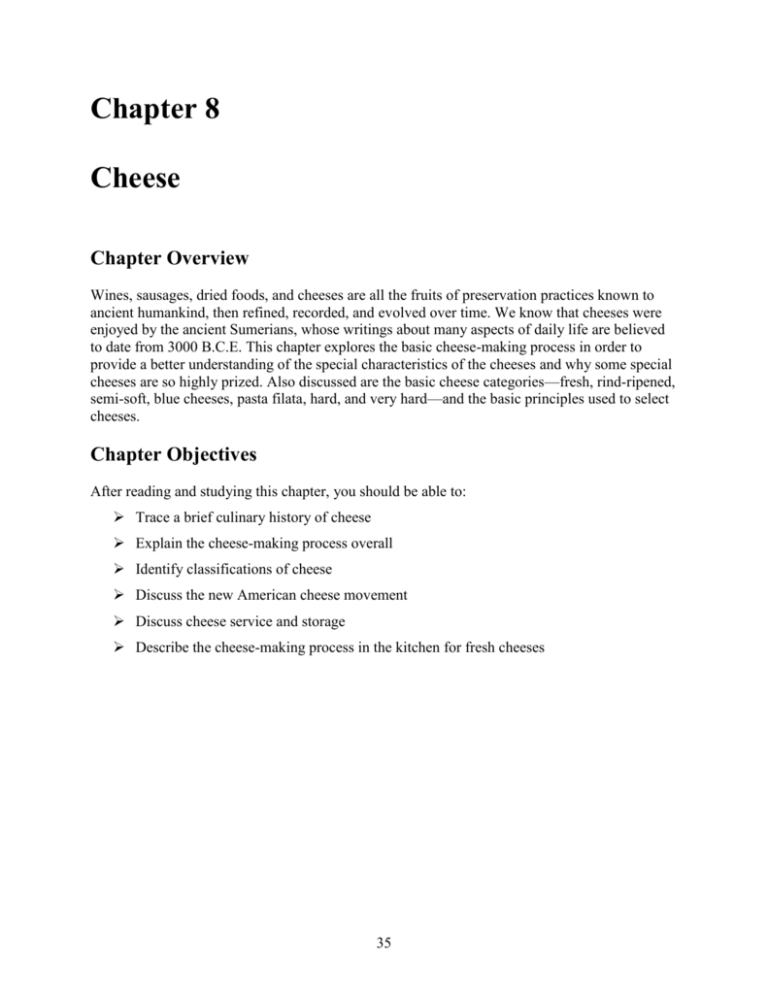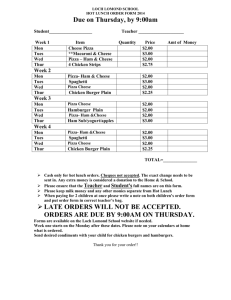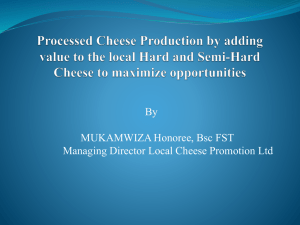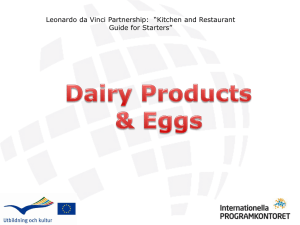Chapter 8
advertisement

Chapter 8 Cheese Chapter Overview Wines, sausages, dried foods, and cheeses are all the fruits of preservation practices known to ancient humankind, then refined, recorded, and evolved over time. We know that cheeses were enjoyed by the ancient Sumerians, whose writings about many aspects of daily life are believed to date from 3000 B.C.E. This chapter explores the basic cheese-making process in order to provide a better understanding of the special characteristics of the cheeses and why some special cheeses are so highly prized. Also discussed are the basic cheese categories—fresh, rind-ripened, semi-soft, blue cheeses, pasta filata, hard, and very hard—and the basic principles used to select cheeses. Chapter Objectives After reading and studying this chapter, you should be able to: Trace a brief culinary history of cheese Explain the cheese-making process overall Identify classifications of cheese Discuss the new American cheese movement Discuss cheese service and storage Describe the cheese-making process in the kitchen for fresh cheeses 35 Study Outline Key Terms and Concepts Cheese Making Artisanal Bacteria Cheese “Natural” cheeses “Processed” cheeses “Pure cultures” Acid starter Acidification Aging Chymosin Coagulation Curds Curing Enzyme starter Heating Homogenizing Milk Pasteurizing Pretreatment Rennet Ripening Salting Separation Shaping Blue-veined cheese Butterfat Cheddaring Dry-rind cheese Eyes Grana Hard cheese Overripe Pasta filata cheeses Rind-ripened cheese Roquefort Semisoft cheese Smear Soft fresh cheese Soft ripened cheese Accompaniments Aromatization Buffet Cheese board Cheese cart Cheese plate Contamination Course Flight of cheeses The Cheese-Making Process Whey Cheese Classification Very hard cheeses Cheese Service Living food 36 Making Cheese in the Kitchen Direct set cultures Nonreactive materials 37 Chapter Exercises True/False ____ 1. The Egyptians were the first to mass produce cheese to be carried on long journeys and be used by their armies as a convenient form of concentrated nutrition. ____ 2. The first real cheese factory was established in 1851 in Rome, New York. ____ 3. Cheese can be made from the milk of all of these animals: cow, goat, sheep, buffalo, llama, camel, mare, and yak. ____ 4. Salt is usually added in the cheese-making process with the starter. ____ 5. Fresh, soft cheeses have a long shelf-life. ____ 6. It is believed that the mold in blue cheeses was first introduced when cheese came into contact with moldy bread. ____ 7. Cheese is a potentially hazardous food; all food contact areas should be cleaned and sanitized properly with hot soapy water and sanitizing solution to prevent crosscontamination. ____ 8. The yellow color of some Cheddars is achieved through the addition of annatto seed paste and has nothing to do with the flavor. Multiple Choice 1. The first cheeses were believed to be made from which animal’s milk? a. Sheep. b. Goat. c. Cow. d. Both a and b. 2. In pasteurization, milk is heated for which of the following reasons? a. To kill bacteria. b. To reduce the fat content. c. To produce more lactic acid. d. None of the above. 38 3. Rennet, an enzyme started in cheese, comes from: a. Animals’ stomachs. b. Certain plants. c. Chymosin. d. All of these. 4. Cheeses may be ripened in: a. Ashes. b. Rinds. c. Leaves. d. All of these. 5. An example of a semi-soft cheese is: a. Monterrey jack. b. Brie. c. Limburger. d. Cheddar. 6. Stilton and Roquefort are two examples of: a. Soft fresh cheese. b. Waxed-ring cheese. c. Blue-veined cheese. d. Pasta filatta cheese. 7. Parmigiano Reggiano is a type of: a. Pasta filata cheese. b. Hard cheese. c. Grating cheese. d. A very hard cheese. Fill in the Blank 1. Cheese is defined as a food product made from _________________________. 2. Since the early 1990s the number of artisan dairies in the U.S. has grown from _______________ to _______________. 3. The _________________ portion of milk that is drained from a cheese curd is known as _________________. 4. ___________________ is a fresh cheese made by curdling heavy cream with citric acid. 5. Rind-ripened cheeses can be broken into two categories: ____________ and _____________ cheeses. 39 6. On a cheese board, cheese should be chosen based on: ______________, ________________, _______________, ____________________, and ___________________. Written/Short Answer 1. Describe the process of making pasta filata cheese. Include examples of pasta filata cheeses and how they differ from each other. 2. Explain the role of salt in cheese-making. 40





